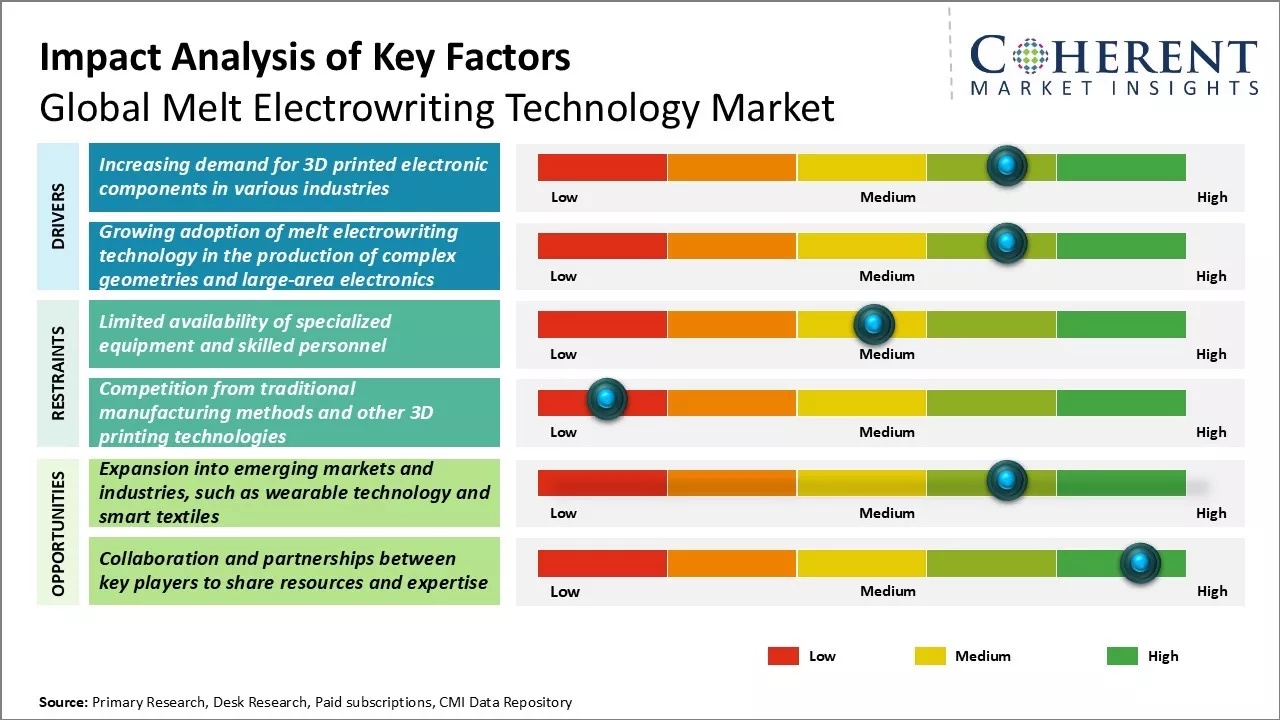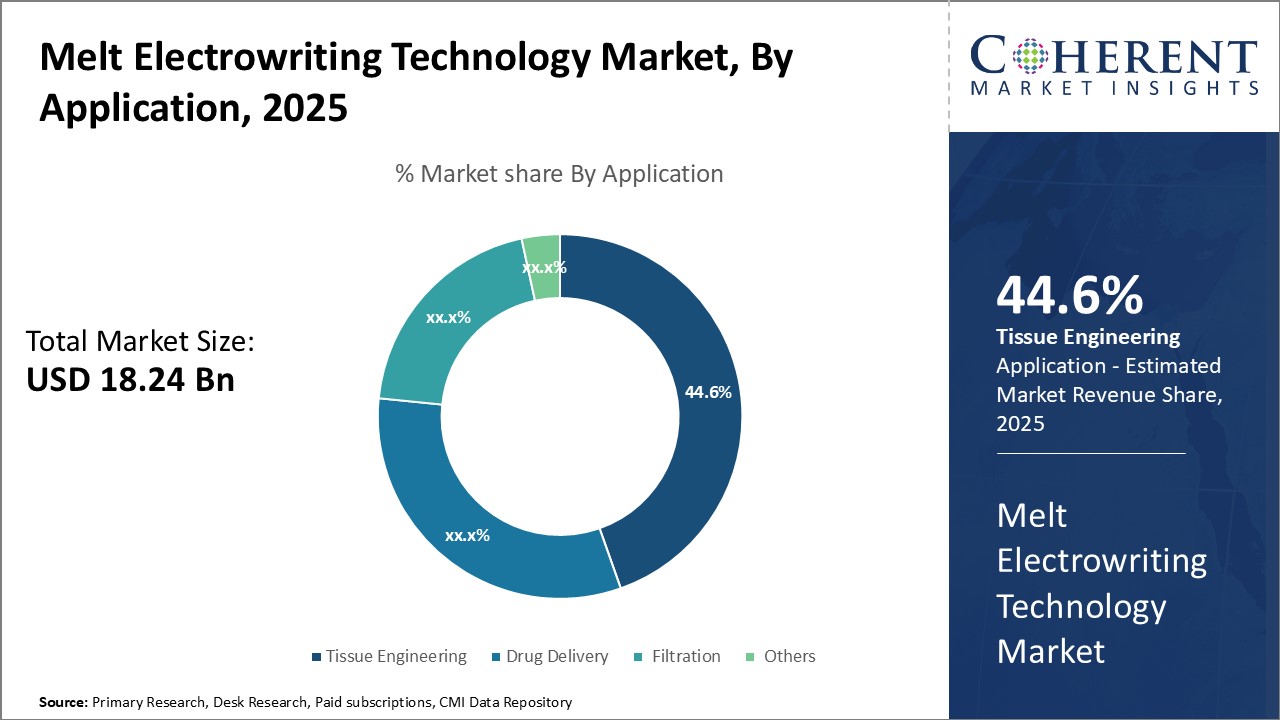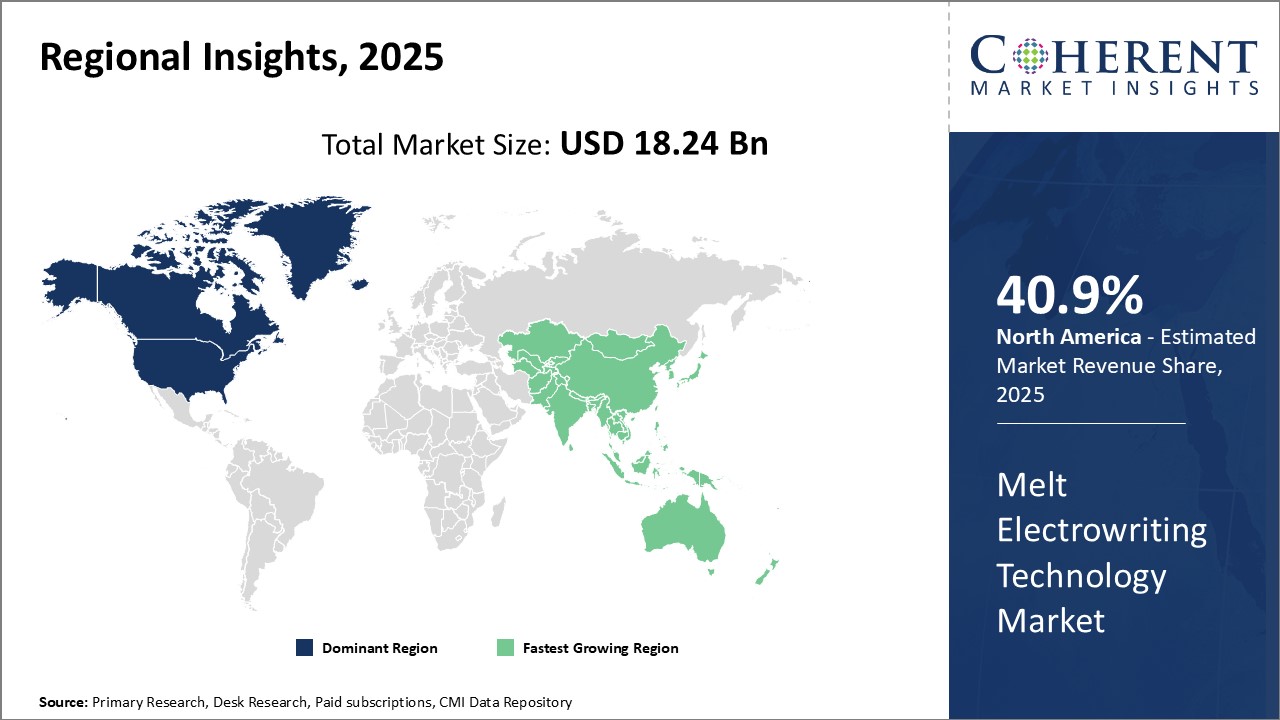The global melt electrowriting technology market is estimated to be valued at USD 18.24 Bn in 2025 and is expected to reach USD 29.12 Bn by 2032, exhibiting a compound annual growth rate (CAGR) of 6.9% from 2025 to 2032.

Discover market dynamics shaping the industry: Request sample copy
The market growth can be attributed to the rising demand for filtration devices and increasing investments in the nanotechnology and biomedical sectors around the world.
Increasing demand for 3D printed electronic components in various industries
The use of 3D printing technology in the production of electronic components has gained significant traction in recent years. Various industries such as consumer electronics, healthcare, automotive, and aerospace have started to see the potential of using 3D printed electronics. This shift towards adopting 3D printing methods for electronics manufacturing is expected to drive significant demand for melt electrowriting technology.
Melt electrowriting is well-suited for the precise fabrication of electronic devices with complex geometries such as wearable electronics, sensors, and flexible circuits. Using melt electrowriting, circuits can be directly printed on diverse substrates, such as plastic, silicone, or paper, without the need for additional processing steps. This allows for the rapid customization and integration of electronics into a variety of form factors required by different applications. Consumer electronics brands are particularly interested in incorporating 3D printed circuits into modern products like smartwatches, VR headsets, etc., to enable new functionalities and create differentiated designs.
The healthcare sector is another promising application area for 3D printed electronics produced using melt electrowriting. Implantable medical devices with customized geometries can potentially be made using this technology. Also, wearable health monitors and flexible sensor strips require electronic components to be seamlessly integrated into flexible substrates - a capability melt electrowriting offers. Even in industries like automotive and aerospace, there lies opportunities to 3D print lightweight sensors and circuits for improved performance monitoring of vehicles using this technique.
With its advantages in design flexibility, customization potential and the ability to fabricate electronics on non-conventional substrates, melt electrowriting is well-positioned to fulfill the growing needs of multiple industries that are increasingly adopting 3D printing solutions. This rising demand across application sectors will substantiate further investment and technical advancements in melt electrowriting technology.

Get actionable strategies to beat competition: Request sample copy
Growing Adoption of Melt Electrowriting for Complex Electronics Manufacturing
Melt electrowriting has demonstrated promising capabilities for the fabrication of large-area and intricate electronic devices. Unlike traditional lithography techniques that face scaling challenges in producing very small or highly complex circuits, melt electrowriting allows printing electronics without limitations of resolution or design complexity. This facilitates the manufacturing of electronics such as RFID tags, OLED displays, biosensors, and photovoltaics which were previously difficult or uneconomical to produce using conventional processes.
Ongoing research efforts to refine melt electrowriting have led to notable improvements in printing resolution, tooling design, and selection of novel inks. These advancements have enhanced its viability for mass manufacturing of electronics with miniaturized or high-density design features. Melt electrowriting also enables the deposition of conductive traces on both rigid and flexible materials, opening up possibilities for applications involving foldable displays, wearables, and implantables. Compared to other 3D printing technologies, melt electrowriting provides superior functionality, conductivity, and resolution of printed electronic components suitable for many real-world applications.
As the technology matures further, its throughput and cost-effectiveness will continue scaling up, making it an industrially robust process. Major players in the electronic fabrications sector have started piloting this technique for commercial production. The scope of electronics that can be melt electrowritten with high fidelity is also expanding steadily. These encouraging signs have prompted many organizations to evaluate transitioning electronics prototyping or specialized manufacturing to melt electrowriting. As its technical feasibility and economic viability strengthens over time vis-a-vis conventional methods, melt electrowriting is forecasted to be widely received for complex electronics fabrication requirements in the future.
Key Takeaways from Analyst:
The growing demand for advanced filtration solutions across several industries such as textiles, healthcare, and automotive will drive the increased adoption of melt electrowriting technology. This technology allows for the fabrication of filters with intricate fiber structures and precise pore sizes, enabling filtration of even nano-scale particles.
North America currently dominates the market and is expected to remain the largest region owing to substantial investments by regional players to develop advanced materials and medical devices using melt electrowriting. However, the Asia Pacific region is likely to offer the most attractive opportunities with China and India emerging as major hubs of innovation. Low manufacturing costs and supportive government policies focused on bolstering domestic industries give the region an edge.
While the opportunities are plentiful, high capital requirement for setting up melt electrowriting facilities remains a major challenge, especially for small players. Also, the complex fabrication process and need for specialized equipment and raw materials increases the technology's susceptibility to supply chain disruptions. Further, intensifying competition from inexpensive traditional filtration methods could hamper faster adoption.
However, ongoing R&D focused on developing new polymers, fiber designs, and scale-up strategies is expected to make melt electrowriting more affordable and versatile.
Market Challenges: Limited availability of specialized equipment and skilled personnel
The global melt electrowriting technology market is currently facing significant challenges due to the limited availability of specialized equipment and skilled personnel required to operate such complex machinery. As melt electrowriting is a highly technical process that requires sophisticated electrified nozzles and precisely controlled melt flow and fiber formation, there are only a handful of equipment manufacturers worldwide that can supply the right setup. Moreover, operating such equipment needs extensive training that is not widely available. As a result, many companies interested in adopting this technology struggle to source the necessary equipment and hire people with the expertise to run production. This equipment gap is restricting the overall ability to scale melt electrowriting operations and commercialize end products. Unless more equipment suppliers enter this market and training institutes start offering credible certifications, this barrier will continue hampering the growth potential of the melt electrowriting technology market.
Market Opportunities: Expansion into emerging markets and industries, such as wearable technology and smart textiles
The global melt electrowriting technology market has significant opportunities to expand into new markets and sectors over the coming years. One such area is the burgeoning field of wearable technology and the development of smart textiles. As melt electrowriting allows intricate circuitry patterns to be directly written onto fabric substrates, this technology could enable a new generation of wearable electronic devices with flexible displays and sensors woven into clothing. It can also integrate connectivity into a wide variety of textile ended-products. With the wearable technology market expected to grow substantially, melt electrowriting is well-positioned to tap into this vertical. Similarly, emerging economies across Asia Pacific, Latin America, the Middle East, and Africa present a major greenfield opportunity for technology suppliers and product manufacturers to introduce novel applications and drive broader adoption of melt electrowriting systems. If actively pursued, these emerging sectors and regions have the potential to accelerate future growth of this market.

Discover high revenue pocket segments and roadmap to it: Request sample copy
Insights By Application - Advancing tissue engineering contributes to the growing share of tissue engineering applications
In terms of application, the tissue engineering segment is expected to contribute 44.6% estimated share of the market in 2025 owing to the constant technological advancements that are expanding the horizon of this domain. Tissue engineering utilizes living cells and biomaterials to build new tissues and organs to repair or replace damaged ones. The increasing cases of organ failure, trauma, tumors, and other conditions creating a huge unmet need for organ transplantation are majorly driving the growth of the tissue engineering segment. Furthermore, factors such as the rising healthcare expenditure, growing geriatric population prone to degenerative diseases, and increasing investments in regenerative medicine research are collectively fueling the demand for tissue engineering worldwide. On the other hand, challenges like high costs associated with the development and manufacturing of tissue engineered products and ethical issues related to embryonic stem cells are slowing down the tissue engineering market to some extent. Overall, ongoing developments in areas of stem cell therapy, 3D bio printing, scaffolds and biomaterials are expected to propel the tissue engineering segment at a substantial rate in the coming years.
Insights By Material - Polymer materials enable diverse tissue engineering applications
In terms of material, the polymers segment is expected to contribute 51.9% estimated share of the market in 2025 due to their excellent biocompatibility and suitability for diverse tissue engineering applications. Polymers are extensively utilized to prepare scaffolds, which provide structural support and signaling cues to guide tissue regeneration. Natural polymers like collagen, fibrin, and synthetic polymers like polyglycolic acid and polylactic acid are widely preferred for preparing tissue scaffolds. As polymers can be easily molded into different structures like fibers, hydrogels etc., they greatly facilitate engineering various tissues. Mesenchymal stem cells, when seeded onto polymeric scaffolds, are capable of differentiating into multiple cell lineages including bone, cartilage and cardiac muscles, thereby engineering the respective tissues. In addition, conductive polymers are finding increasing usage for nerve regeneration purposes. The tunability of polymers makes them valuable frameworks for controlled delivery of bioactive molecules as well. These advantages have cemented polymer's position as the dominant material for tissue engineering research and products.
Insights By End User - Pharmaceutical companies focus on advanced therapies to drive tissue engineering growth
In terms of end user, pharmaceutical and biotechnology companies is expected to contribute 46.7% share of the market in 2025 owing to their extensive focus on developing advanced therapies using tissue engineering technologies. Pharmaceutical giants are actively collaborating with academia and investing heavily in stem cell research, regenerative medicine, and tissue-engineered products development. They foresee huge market opportunities for tissue-engineered skin, bone grafts, blood vessels, and other structures to address underserved medical needs. Likewise, cell therapy development targeting conditions such as Parkinson's disease, diabetes, cancers, etc. is another key area attracting big investments from pharmaceutical players. With their deep R&D expertise and financial prowess, pharmaceutical companies are at the forefront of the clinical translation of tissue engineering innovations. This allows them to be the first to market novel tissue engineered products and cell therapy applications. Additionally, medical device manufacturing arms of many pharmaceutical firms are involved in developing cutting-edge technologies for tissue engineering applications as well. Continued efforts by pharmaceutical companies to leverage the vast potential of tissue engineering will drive significant growth in this end user segment.

Need a Different Region or Segment? Customize now
North America has established itself as the dominant region in the global melt electrowriting technology market. The region is expected to hold 40.9% estimated share of the market in 2025. The large presence of key players from countries like the U.S.s and Canada has enabled North America to have the most advanced electrowriting infrastructure and capabilities. Major technology companies have their R&D centers based in the region and are investing heavily in developing new electrowriting products. Additionally, government funding towards nanotechnology research provides support to the development of more efficient electrowriting methods. With an emphasis on innovation, North American companies can quickly commercialize new designs and solutions. This allows them to cater to various applications across industries like biomedical, energy, and electronics. Their expertise also helps North American players export electrowriting systems to other parts of the world.
Asia Pacific has emerged as the fastest growing regional market for melt electrowriting technology. Countries like China, Japan, South Korea, and India have thriving industrial sectors, increased foreign investments, and a growing middle-class driving the demand for new materials and technologies. Many global corporations are setting up manufacturing plants in Asia Pacific utilizing electrowriting for prototyping and mass production. Additionally, governments across Asia Pacific are supporting local R&D by providing grants and establishing research parks involving universities and private firms. This is aiding the development of cost-effective electrowriting solutions tailored for Asian industries. As local players gain more experience, export of electrowriting products from Asia Pacific is rising. Their affordable processes also gain traction from price-sensitive sectors. With continued industrialization and R&D investments, the Asia Pacific region is well placed to grow its share in the melt electrowriting technology landscape over the coming years.
Melt Electrowriting Technology Market Report Coverage
| Report Coverage | Details | ||
|---|---|---|---|
| Base Year: | 2024 | Market Size in 2025: | USD 18.24 Bn |
| Historical Data for: | 2020 To 2024 | Forecast Period: | 2025 To 2032 |
| Forecast Period 2025 to 2032 CAGR: | 6.9% | 2032 Value Projection: | USD 29.12 Bn |
| Geographies covered: |
|
||
| Segments covered: |
|
||
| Companies covered: |
3D Biotek, Abiogenix, Avery Dennison, Biomedical Structures, Cambus Medical, Celanese, Confluent Medical Technologies, DSM Biomedical, Evonik, Freudenberg Medical, Huizhou Foryou Medical Devices, Jiangsu Hengtong Medical Equipment, Jiangsu Tongxiang Medical Equipment, Kuraray, and Medtronic |
||
| Growth Drivers: |
|
||
| Restraints & Challenges: |
|
||
Uncover macros and micros vetted on 75+ parameters: Get instant access to report
*Definition: The global melt electrowriting technology market consists of companies that develop and commercialize melt electrowriting technology solutions. This technology uses electrical forces to produce fibers from melted materials for applications such as filtration, biomedical sciences, energy, and electronics. The melt electrowriting process creates melt-based fibers on the micro- and nanoscale levels through precisely controlled electric fields.
Share
Share
About Author
Ramprasad Bhute is a Senior Research Consultant with over 6 years of experience in market research and business consulting. He manages consulting and market research projects centered on go-to-market strategy, opportunity analysis, competitive landscape, and market size estimation and forecasting. He also advises clients on identifying and targeting absolute opportunities to penetrate untapped markets.
Missing comfort of reading report in your local language? Find your preferred language :
Transform your Strategy with Exclusive Trending Reports :
Frequently Asked Questions
Joining thousands of companies around the world committed to making the Excellent Business Solutions.
View All Our Clients
US Reciprocal Tax Impact Analysis On Melt Electrowriting Technology Market
Stay updated on tariff changes with expert insights and timely information